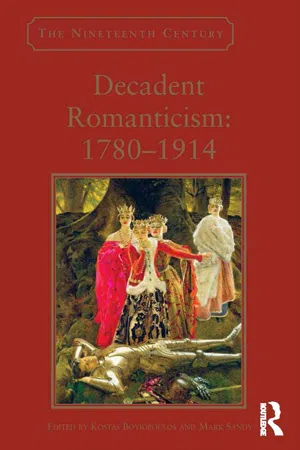
- 226 pages
- English
- ePUB (mobile friendly)
- Available on iOS & Android
Decadent Romanticism: 1780-1914
About This Book
For Decadent authors, Romanticism was a source of powerful imaginative revisionism, perversion, transition, and partial negation. But for all these strong Decadent reactions against the period, the cultural phenomenon of Decadence shared with Romanticism a mutual distrust of the philosophy of utilitarianism and the aesthetics of neo-Classicism. Reflecting on the interstices between Romantic and Decadent literature, Decadent Romanticism reassesses the diverse and creative reactions of Decadent authors to Romanticism between 1780 and 1914, while also remaining alert to the prescience of the Romantic imagination to envisage its own distorted, darker, perverted, other self. Creative pairings include William Blake and his Decadent critics, the recurring figure of the sphinx in the work of Thomas De Quincey and Decadent writers, and Percy Shelley with both Mathilde Blind and Swinburne. Not surprisingly, John Keats's works are a particular focus, in essays that explore Keats's literary and visual legacies and his resonance for writers who considered him an icon of art for art's sake. Crucial to this critical reassessment are the shared obsessions of Romanticism and Decadence with subjectivity, isolation, addiction, fragmentation, representation, romance, and voyeurism, as well as a poetics of desire and anxieties over the purpose of aestheticism.
Frequently asked questions
Information
Chapter 1 Perverse Forms: Reading Blake's Decadence
All that was accepted for art, all that was taken for poetry, he rejected as barren symbols. 1
No doubt perversity of form and perversity of matter are often found together, and, among the lesser men especially, experiment was carried far, not only in the direction of style. 13
Blake was the most perverse of mortals, except to his own ideals, his own inspiration. To these he was loyal beyond praise and beyond words: to aught else equally impenetrable and contumacious.… If those who urged him to do lofty things by common processes were in the right, then Blake was not only in the wrong but perverse, a ‘son of perdition’. If Blake on the other hand was essentially right as to his aims and methods, then the rugged gradient of his perversity was also an ascending plain of heroism. 15
Table of contents
- Cover Page
- Half-Title Page
- Series
- Title Page
- Copyright Page
- Table of Contents
- List of Illustrations
- Notes on Contributors
- Acknowledgements
- Introduction: Decadent Romantics, Romantic Decadents
- 1 Perverse Forms: Reading Blake's Decadence
- 2 Incest on the Romantic Stage: Baillie, Byron, and the Shelleys
- 3 Wordsworth's and Byron's Links with British and French Decadence
- 4 ‘Enchanted wine': Symons, Dowson, and Keats’s Intoxications
- 5 Keats's Visual Legacy in Book Illustration at the Turn of the Century
- 6 Enigmatic Intertexts: Decadence, De Quincey, and the Sphinx
- 7 ‘Stars Caught in My Branches': Swinburne and Shelley
- 8 Mathilde Blind: A Decadent Shelleyan
- 9 ‘The Last Great Romantic': Nietzsche’s Romanticism Out of the Spirit of Decadence
- 10 Decadence and the Fate of the Romantic Sublime
- 11 ‘Phantoms of Delight': Amy Levy and Romantic Men
- 12 Soldiers of the Queen: The War Poetry of Kipling and Newbolt
- Selected Bibliography
- Index